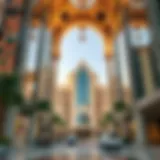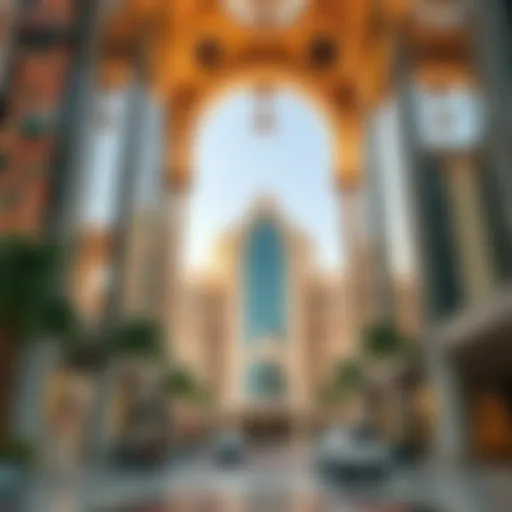Navigating the Dubai Metro: Understanding Zone Connectivity
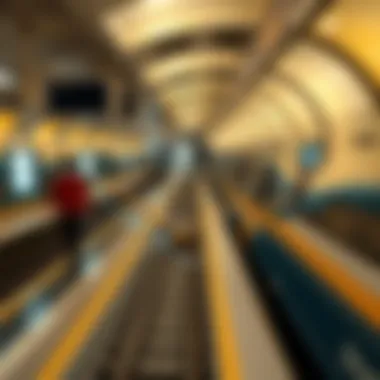

Intro
Understanding urban transport is crucial, especially in a place like Dubai, where modernity meets tradition. The Dubai Metro is more than just a means of travel; it is a vital thread in the fabric of the city, interconnecting various districts and offering a glimpse into its vibrant lifestyle. This guide will delve into the significance of the Dubai Metro zones map, which is an essential tool for anyone navigating the city's extensive transit system. Whether you're a new resident, a tourist, or someone looking to invest in property, grasping the layout of the metro zones can significantly enhance your experience and your understanding of the local real estate landscape.
The zones encompass various key areas of the city, influencing property values and accessibility. Understanding how these zones work can make finding the right area for living or investing much more manageable. In this guide, we aim to provide clarity on the zones, highlight current trends in the Dubai real estate market, and offer practical tips for buying and selling property that connects to the metro system.
It's not just about where to catch a train; it's about knowing how to navigate a city that thrives on dynamic growth and opportunity. The insights laid out in this article will serve investors and homebuyers alike, enlightening them about the synergy between public transport and real estate trends.
With that in mind, let's explore the Market Insights related to the Dubai Metro zones.
Prolusion to Dubai Metro
Understanding the Dubai Metro is pivotal for anyone trying to navigate the expansive urban fabric of this bustling city. The metro system is more than just a means of transport; it serves as a backbone for urban mobility, connecting various districts and enhancing the daily commute for residents and visitors alike. This guide not only sheds light on the zones of the metro but also lays out its practical implications for real estate and investment opportunities in Dubai.
Overview of the Metro System
The Dubai Metro is a cutting-edge transportation system that spans approximately 75 kilometers with over 50 stations. Launched in 2009, the metro stands as a marvel of engineering, built to cater to the rising population and the surge in tourism. Operating on a fully automated service, it ensures comfort and speed for its users. The metro operates two primary lines: the Red Line and the Green Line, which interconnect at several key points, offering seamless transit throughout the city.
The metro is tailored to link essential city zones, from residential areas to commercial hubs and major tourist attractions. This is where understanding the zones becomes critical for effective navigation. Whether you're a daily commuter or a first-time tourist, familiarizing yourself with the metro map and its zones is an absolute must for efficiency.
One of the standout features of the metro system is its affordability. For most travelers, hopping on the train is not just a time-saver but also a wallet-friendly option when compared to alternative modes of transport such as taxis. Moreover, the stations are designed with accessibility in mind, ensuring that everyone can enjoy Dubai’s vibrant cityscape without fuss.
Historical Development
The story of the Dubai Metro is as captivating as the city itself. Its inception traces back to the early 2000s, when Dubai's rapid growth necessitated a reliable and efficient public transport system. Initially proposed in response to growing traffic congestion, the first line was finally operational in 2009, marking a significant milestone in the city's development.
From the get-go, the metro was envisioned as a sustainable solution to combat pollution and improve air quality in the city. The project wasn't without its challenges, facing both technological hurdles and financial scrutiny during its initial phases.
However, with the support of the Dubai government, the project gained momentum. By 2010, the metro had expanded with the Green Line, further enhancing connectivity. Now, as part of broader plans for development, future extensions are on the table, promising even greater reach and efficiency in a metropolis that continues to evolve.
"Dubai Metro is not just a transit system; it’s a glimpse into the future of urban mobility."
As this introduction highlights, the Dubai Metro is integral not just to urban transit, but also to shaping city dynamics and influencing real estate trends. Studying its zones will help investors and homebuyers alike make informed decisions that align with the metro's growth and accessibility.
Understanding the Dubai Metro Zones
Navigating the complexities of a bustling metropolis like Dubai takes more than just a good map and an adventurous spirit. The Dubai Metro Zones serve as a key element in this labyrinth, offering valuable insight into urban mobility while shaping the daily commutes of thousands. Understanding these zones can be a game changer, not only for residents but for investors and visitors aiming to make the most of their time in the city. This section delves into what metro zones are, their classifications, and why comprehending these divisions can maximize the effectiveness of your travels and real estate decisions.
Defining Metro Zones
Metro zones in Dubai are not just arbitrary divisions; they are thoughtfully designed segments that categorize various parts of the city based on their geographical and functional characteristics. Simply put, if you picture a pie, the metro zones represent slices that cater to distinct purposes — whether commercial, residential, or recreational.
For instance, they facilitate a streamlined navigation approach that benefits both the daily commuter and the casual traveler. By defining these zones, the metro system ensures that fare structures are clear, which directly influences budgeting for travel. Knowing that Metro Zone One covers Central Dubai, you might think twice before deciding to venture downtown when other options are readily available. Each zone serves a particular demographic need, whether it's housing professionals working in skyscrapers or tourists flocking to iconic attractions.
Zone Categories and Their Purposes
Dubai's metro zones can be categorized into five key types, each carrying its own unique characteristics and implications for both travel and real estate opportunities:
- Commercial Zones: These areas are teeming with offices, retail spaces, and booming businesses. For homebuyers and investors, understanding the proximity of residential areas to these zones may aid significant decisions.
- Residential Zones: The quieter neighborhoods that tend to host families and expatriates seeking comfort away from the hustle and bustle of downtown. Here, the presence of schools and parks makes a big difference in attracting potential buyers.
- Tourist Zones: Featuring attractions like the Burj Khalifa and Dubai Mall, these zones are crucial for the tourism-based economy of the city. Being close to these high-traffic areas can exponentially increase rental demand and property value.
- Cultural Zones: Areas rich in heritage, art, and local flavor, appealing to a different kind of resident and traveler. These spaces often cater to those who seek a deeper connection with the city’s roots.
- Transport Hubs: Not just metro stations, but also bus terminals and connections to airports fall into this category. They play a significant role in enhancing commuter convenience and accessibility.
Understanding these categories and their purposes allows commuters and investors alike to make informed choices that align with their objectives, whether it’s ease of travel or potential for property appreciation. The effects are tangible.
"Navigating through Dubai's location zones can significantly impact not just your daily travel but also investment strategies in real estate."
Thus, the Dubai Metro Zones are not simply divisions on a map; they are intricate frameworks that shape interaction with the city. Investors and homebuyers can gain significant insights through a thoughtful analysis of these zones, pushing their understanding beyond the surface. Whether optimizing travel routes or making pivotal property decisions, the significance of these zones can’t be overstated.
Detailed Breakdown of Each Zone
Understanding the distinct zones within the Dubai Metro is crucial for anyone looking to navigate the city with ease. Each zone has its own unique character, significance, and role that contribute to the metropolitan experience. By breaking down each zone, we delve deeper into what makes the Dubai Metro not just a mode of transportation, but a lifeline that connects residents and visitors to their destinations efficiently. This breakdown enables not only easier navigation but also informed decision-making for real estate investments, urban mobility strategies, and ultimately, an enriched experience of life in this bustling city.
Zone One: Central Dubai
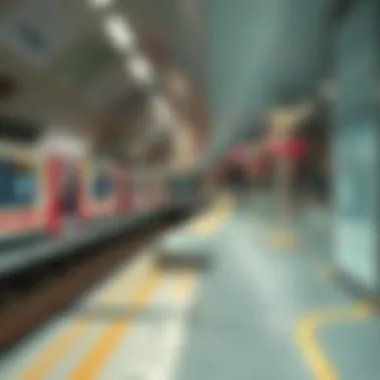

This is the heart of Dubai, often bustling with activity and teeming with energy. Zone One encapsulates major landmarks such as the Dubai Mall and the Dubai Aquarium. Its accessibility via the metro makes it a prime location for both businesses and residents. Property values here often reflect this demand. The area caters to those with a penchant for convenience.
Key Features of Zone One:
- Proximity to high-end shopping and entertainment venues.
- Strong foot traffic that supports commercial viability.
- Blend of residential and commercial spaces, appealing to diverse demographics.
Zone Two: The Burj Khalifa Area
Zone Two is where you find the iconic Burj Khalifa, the tallest building in the world. Besides the grandeur of the skyscraper itself, this area boasts several luxury hotels and exclusive residences. It attracts both corporate professionals and tourists alike, providing a high-stakes environment for real estate investment.
Insights into Zone Two:
- Upscale dining and commercial spaces catering to affluent clientele.
- Potential for high return on investment for property buyers.
- A vibrant social scene fortified by leisure activities and events.
Zone Three: Residential Districts
Diverging from the buzz of commercial sectors, Zone Three presents a more relaxed atmosphere. Comprising various residential neighborhoods, it appeals particularly to families and long-term residents. This zone often features a mix of apartments and villas, making it an attractive option for homebuyers and renters seeking stability.
Characteristics of Zone Three:
- Diverse housing options suited for different family sizes and income levels.
- Proximity to schools, parks, and community amenities promoting family-friendly living.
- Emerging neighborhoods may offer competitive property pricing, a tempting aspect for investors.
Zone Four: Commercial Hubs
As the name suggests, Zone Four is predominantly focused on commercial activities. From large corporate office spaces to tech startups, this zone is a magnet for companies looking to establish a presence in Dubai. It plays a crucial part in the city's economic fabric, and understanding its dynamics is key for investors looking to capitalize on commercial real estate opportunities.
Notable Aspects of Zone Four:
- High concentration of businesses, making it a bustling area.
- Opportunities for co-working spaces catering to freelancers and startups.
- Potential for lucrative returns in the commercial real estate sector.
Zone Five: Tourist Attractions
This zone is all about leisure and attractions, often bustling with tourists. It encompasses some of the most famous sites like Jumeirah Beach and the Palm Jumeirah. These vibrant locations not only draw visitors but also impact local real estate by creating demand for short-term rental options and hotels.
Tourist Focus in Zone Five:
- High potential for developers interested in hospitality and tourism-related properties.
- Seasonal fluctuations can affect property value, important to consider for investment.
- An intertwining of local culture and tourism, enriching the area’s appeal.
Understanding these zones helps consumers and investors alike to navigate the market with awareness, benefiting from the connectivity that the Dubai Metro provides.
The detailed examination of each zone reveals layers of opportunity and livability. Ultimately, it arms potential buyers and renters with the necessary insights to make informed decisions in an ever-evolving market.
Navigating the Zones Effectively
Successfully navigating the Dubai Metro can transform how residents and visitors experience the city. Understanding how to utilize the zones effectively enables shorter travel times and can inform better real estate decisions. In this segment, we will cover fare structures, transport cards, and the overall benefits of mastering the metro system.
Understanding Fare Structures
The fare structure of the Dubai Metro is carefully designed yet can be rather puzzling for newcomers. It employs a zone-based pricing system, where commuters pay based on the number of zones traversed during their journey. Here are some key points to help clarify:
- Zone Categories: Each zone is demarcated on the metro map. Generally, the more zones you cross, the higher your fare. Zones are usually color-coded on the map to easily identify them.
- Fare Tiers: The fare isn’t uniform; it varies depending on whether you are traveling in the Gold Class cabin or standard cabin. The Gold Class offers a premium experience at a premium fare.
- Discount Types: Various discounts are available to students, senior citizens, and people with disabilities, ensuring that public transport is accessible to all.
Keeping an eye on your fare can help you avoid unnecessary expenses while exploring different areas of Dubai. Ultimately, understanding these structures can assist both investors and daily commuters in estimating transportation costs when choosing property in various zones.
Using the Transport Card
Utilizing the Nol card is vital for navigating the Dubai Metro efficiently. This smart card system is designed to streamline the fare payment process and enhances overall travel convenience.
- Types of Cards: The Nol card comes in different varieties – Red for tourists, Silver for residents, and Gold for those seeking a premium journey. The right choice can depend on the frequency of use.
- Top-Up Options: Top-up stations are available at virtually every metro station. You can reload using cash or card, making it easy to maintain a balance at your convenience.
- Travel Benefits: Besides metro rides, the Nol card can also be used on buses, water buses, and trams, promoting seamless connections across various modes of transport.
- Tracking Expenses: One significant advantage is the ability to track travel history and expenses through an online portal, enabling users to manage their transport budget effectively.
In summary, mastering how to navigate the zones of the Dubai Metro system—understanding fare structures and effectively using the transport card—can significantly enhance the commuting experience. This knowledge not only aids in personal travel efficiency but also forms a critical part of urban navigation that can influence real estate choices for potential investors.


Real Estate Implications of Metro Zones
The Dubai Metro plays an essential role in shaping the real estate landscape in the city. Understanding the relationship between metro zones and property values can significantly influence decisions for investors, homebuyers, and developers. The strategic locations of metro stations often translate into increased accessibility, which tends to enhance property desirability, thus leading to higher valuations. As the saying goes, "Location, location, location!" This expression holds true particularly in a city like Dubai, where efficient transportation networks are a considerable draw for potential buyers.
Convenient access to the metro not only impacts residential areas but also boosts commercial properties. Businesses located near metro stations often experience greater foot traffic, increasing their potential customer base. This has been particularly evident in areas like Jumeirah Lakes Towers and Dubai Marina, where properties enjoy a premium due to their proximity to transit hubs. Moreover, the city’s ambitious expansion plans envision additional metro lines, creating a ripple effect on surrounding areas’ real estate markets.
In brief, proximity to the Dubai Metro can be a key determinant in assessing property values, reflecting a broader trend in urban planning. As a result, savvy investors should closely monitor metro zones when considering property purchases in the city.
Impact on Property Values
The influence of metro zones on property values cannot be overstated. Properties within close proximity to metro stations tend to command higher prices compared to those located further away. A study by the Dubai Land Department revealed that properties near metro stations appreciate more than 30% within just a few years of transit improvements. This figure underlines the importance of understanding the dynamics of metro zones for anyone looking to invest.
Key Factors Influencing Property Values:
- Accessibility: Easy access to public transport can draw potential buyers or tenants, increasing demand.
- Neighborhood Development: Areas around metro stations often attract further development, leading to overall growth in the region.
- Quality of Life: Residents often seek out metro-adjacent locations due to reduced commute times and improved connectivity, enhancing their lifestyle.
"Investing in properties near metro stations is not just a trend; it's a strategic decision that can offer significant returns."
Investing Strategies Based on Zones
Investing in real estate requires an astute understanding of market dynamics, particularly in relation to the metro zones. A one-size-fits-all approach won't cut it in a city as diverse as Dubai; rather, tailored strategies can yield better results. Here’s how investors can navigate their options based on metro zones:
- Focus on Emerging Areas:
- Evaluate Mixed-Use Developments:
- Monitor Infrastructure Projects:
- Assess Market Trends:
- Investigate zones that are planned for metro expansion; areas such as Dubai South stand out due to future connectivity plans.
- Properties in mixed-use developments near metro stations often attract higher rental yields due to their versatility and convenience.
- Keep an eye on ongoing transportation and infrastructure projects, as improved connectivity often leads to property appreciation.
- Study current property trends in various zones to identify undervalued properties that are likely to surge once a new metro line opens.
These strategies reflect a nuanced understanding of not just the real estate market, but also how it interlinks with broader urban mobility trends. In essence, leveraging insights about metro zones can provide investors with a competitive edge in the bustling Dubai market.
Accessibility and Connectivity
Understanding how the Dubai Metro integrates with other transport systems creates an essential tapestry of urban mobility in the city. Accessibility can be the make-or-break factor in determining how well a city functions for its residents and visitors. Within the context of the Dubai Metro, the interplay with other transport modalities accentuates the efficacy of public transit and its impact on real estate decisions.
Linking to Other Transport Systems
Dubai's Metro network is more than just a series of rail lines; it is a nexus connecting various transport options, like bus networks, taxis, and water transport. This integration greatly aids commuters, streamlining their journeys from one point to another.
- Buses: Numerous bus routes feed into Metro stations, ensuring that even the farthest residential and commercial areas are reachable. The buses operate with a time schedule that generally matches the Metro, making for a seamless transition between modes.
- Taxis: A taxi rank is typically located at every major Metro station. This facility is essential for commuters needing to travel , especially after Metro operating hours.
- Water Transport: In Paris you might jump from the subway to the riverboats, here in Dubai, passengers can catch abras at piers near stations like Burj Khalifa, adding both charm and efficiency to travel.
This connectivity enhances property values; businesses thrive where ease of movement exists. For instance, those looking to invest in the Dubai Marina will benefit not just from the allure of the waterfront but from the ease of mobility enjoyed by residents and visitors alike.
Journey Planning for Optimal Experience
Navigating the Dubai Metro system can be a walk in the park when one employs effective journey planning. Being strategic about your travels can save not just time but also expenses, especially pertinent for investors or individuals searching for their next home.
- Use the Metro Map: Familiarize yourself with the Metro map, aka the lifeline of Dubai’s urban transit. Mapping out your route in advance helps you visualize your journey and minimizes last-minute surprises.
- Timing is Key: Peak hours typically see a crowd that can rival a concert's attendance. If you can, find a sweet spot during off-peak hours. Not only do you enjoy a less packed train, but it can also be more of a leisurely ride, allowing you to take a moment and appreciate the scenery as you travel.
- Mobile Applications: Utilizing apps like RTA Dubai's official app can be a game-changer. They provide real-time updates, route suggestions, and alerts about service disruptions which could lead to some hiccup-free traveling.
A methodical approach not only makes commuting easier, but if you’re a prospective buyer, it also allows you to assess which neighborhoods are well-served by public transport. Opting for homes within walking distance of Metro stations could pay dividends down the line.
"Understanding connectivity isn't just about reaching your destination; it's about enriching lifestyle choices and informed investments."
In summary, focusing on accessibility and connectivity isn't merely a matter of convenience. It's a cornerstone of urban living that influences both day-to-day experiences and long-term real estate trends in Dubai. The flow of movement in and around Metro zones weaves into the city’s broader narrative about vibrant living and smart investments.
Challenges of the Metro System
The Dubai Metro system stands as a remarkable feat of engineering and urban planning. Yet, like any bustling metropolis, it faces challenges that can affect the overall efficiency and experience of users. In recognizing these challenges, we can appreciate both the triumphs and difficulties of navigating this vital transportation network. This section addresses two primary challenges: overcrowding and the maintenance of infrastructure.
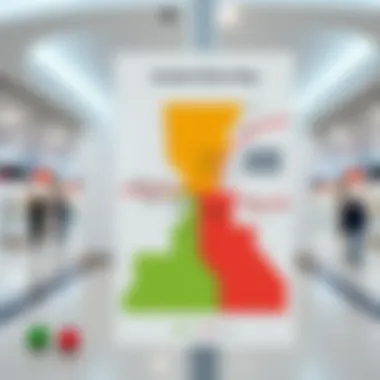

Overcrowding Issues
One of the most pressing concerns with the Dubai Metro is overcrowding. As the city continues to expand, more people rely on public transit daily, especially during peak hours. This leads to trains filled to capacity, with commuters often spilling over into the station platforms. It creates an uncomfortable environment, making the experience less pleasant for everyone involved.
Factors contributing to overcrowding include:
- Population Growth: The continuous influx of residents and tourists fuels demand.
- Limited Frequency: Although trains run frequently, during rush hour, they still struggle to accommodate the volume of passengers.
- High Accessibility: Strategic stations like those near Burj Khalifa and Dubai Mall attract large crowds, compounding the situation.
To mitigate these issues, the authorities are exploring various strategies, such as enhancing train frequency and optimizing the schedule. However, an intrinsic challenge remains: balancing operational efficiency with passenger comfort.
"With the rising number of commuters, the comfort of using the Metro can easily become a thing of the past, unless proactive measures are put in place."
Maintaining Infrastructure
Another critical challenge for the Dubai Metro system lies in maintaining infrastructure. Infrastructure maintenance is essential for ensuring safety and reliability, yet it often goes unnoticed until things go awry. With decades of heavy use expected, the wear and tear on tracks, trains, and stations are inevitable.
The major aspects of infrastructure maintenance include:
- Regular Inspections: Continuous monitoring is crucial to identify potential issues before they escalate.
- Updating Technology: Outdated systems can lead to inefficiencies. Upgrading technology must be a priority to keep pace with growing demands.
- Addressing Wear and Tear: Everyday use puts stress on various components, needing timely repairs to prevent service disruptions.
Furthermore, funding for ongoing maintenance can be a challenge. As resources get allocated to expansion, it is vital not to lose sight of the existing system’s upkeep. Prioritizing maintenance is essential not only for safety but for sustaining a reliable metro network that meets the evolving needs of Dubai's residents and visitors.
Future Developments and Enhancements
In the ever-evolving urban landscape of Dubai, the Metro system remains a crucial element in managing the city’s growth. Focusing on future developments and enhancements is not just about keeping up with technological advancements, but understanding how these innovations can improve overall user experience and accessibility. As more residents and tourists flock to this magnificent city, the emphasis on an efficient transit system becomes paramount. Thus, comprehensively grasping the plans for expansion and improvement will be critical for investors and residents alike.
Proposed Expansions
One of the most significant facets of future developments involves proposed expansions that target improving coverage across Dubai’s metropolitan area. New lines and extensions are on the drawing board; once completed, they will ensure that even the most remote neighborhoods are connected to the Metro. Here's what to expect:
- New Routes: Additional lines are planned to incorporate areas like Dubai South, which is anticipated to be a burgeoning hub in the next decade.
- Increased Stations: Existing routes will see the introduction of more stations, making access easier for commuters moving to and from various regions.
- Enhanced Connectivity: The expansions are designed not only to bolster metro coverage but to ensure smooth transitions between the Metro and other transport systems, further simplifying the journey for users.
These expansions will also influence property values significantly, as areas adjacent to these new lines typically see an uptick in investments. Understanding these planned phases is essential for homebuyers and investors eager to capitalize on future property growth.
Technological Advancements in Transit
With proposed expansions come substantial technological advancements aimed at refining and modernizing the transit experience. As cities like Dubai embrace the future, these changes are instrumental in making the Metro system more user-friendly. Some notable advancements include:
- Smart Ticketing Systems: Enhanced ticketing solutions are coming into play, allowing users to access transportation seamlessly through mobile apps. This upgrade significantly reduces the need for physical tickets, expediting the boarding process.
- Real-Time Updates: Improvements in communication technology will provide real-time data on train schedules and delays. Users will have access to updated information at their fingertips, ensuring efficient journey planning.
- Sustainable Transportation Solutions: Innovations aimed at reducing emissions, such as electric trains and better energy management systems, are being integrated, aligning with global sustainability goals.
By merging technology with public transport, Dubai is on a path to foster a healthier commuting environment while enhancing user engagement.
Investors who stay informed on these developments will find themselves well-positioned to make lucrative real estate ventures in areas benefitting from these enhancements.
Investing time in understanding the future trajectory of the Dubai Metro system is not merely an exercise in curiosity; it's fundamental for anyone looking to navigate the dynamics of urban mobility and the potential it holds for real estate ventures.
For further reading on the impact of public transit on real estate, you can check this article or explore community discussions on platforms like Reddit.
Closure
Navigating the intricate network of the Dubai Metro and its zones is more than just a matter of convenience; it is a vital key to understanding urban mobility within the city. The exploration and comprehension of the Dubai Metro Zones Map not only serve as a practical guide for residents and visitors but also offers significant insights for investors and property enthusiasts alike. Knowing how zones are structured can make a world of difference when weighing options for property investments or even day-to-day commuting decisions.
Summary of Key Insights
The Dubai Metro operates through well-defined zones that are critical for fare calculations and travel efficiently around the city. Each zone caters to different aspects of urban life, from bustling commercial hubs to serene residential neighborhoods. Here are some pivotal insights that this article brings to the forefront:
- Diverse Experiences: Each zone offers a unique flavor, symbolizing the diversity within Dubai itself. For instance, Zone One captures the bustling heart of the metropolis, while Zone Five showcases the city's tourism attraction.
- Financial Considerations: Investors should be acutely aware that proximity to metro stations can positively affect property values. Areas well-connected by the metro tend to appreciate more rapidly compared to those isolated from the system.
- Commuter Efficiency: Understanding the zones helps in route optimization. Commuters can plan their journeys around peak hours, saving both time and effort.
Final Thoughts on Metro Zones and Real Estate
As Dubai continues to develop, the relationship between metro zones and real estate will become even more pronounced. Properties near metro stations are not just attractive for their connectivity, but also for their potential as long-term investments. The strategic positioning of the Metro makes certain areas desirable, potentially edging out properties farther from public transport accessibility.
In summary, by grasping the essence of metro zones, investors can make informed decisions that align with the growth trajectory of Dubai, ensuring that they tap into not just present value but future opportunities as well. With state-of-the-art technology, planned expansions, and ongoing community efforts, the Dubai Metro is shaping a future where connectivity enhances both daily living and investment landscapes.
"The key to successful navigation in Dubai lies within the Metro's connectivity—understanding its zones unlocks new opportunities in real estate."
For additional insights and updates on Dubai's evolving landscape, prospective investors and real estate agents can rely on resources such as Dubai Land Department and gulfnews.com.
Through careful navigation of the metro zones and an understanding of real estate implications, one can truly appreciate the vibrancy and potential of Dubai.








